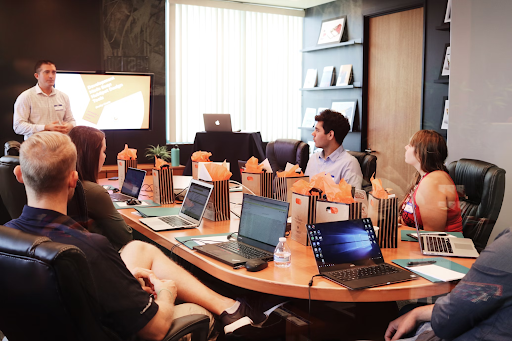
On the job learning – breaking out of the great confinement
We live in a different world to the world we lived in last week. Different to the one we'll occupy next week. The business world evolves at such a greater rate nowadays, even more so in times of financial difficulties. Corporations, Public Bodies and Educational establishments need to consistently rethink how they react in and with the world in order to maintain performance.
A rise in the need to access vast amounts of information, and constantly evolving methods of communication bring new ways of thinking, new ways to react and to interact. Most importantly, it means a new way of working, and by extension, a new way of learning.
In the years since the Second World War, with the need to rebuild and re-educate becoming more prevalent, learning for work became formalised, classroom based and tutor led. Such methods became the go-to method for the private sector and the public sector alike for the next five or six decades.
Michel Foucault, the French philosopher and social theorist referred to classroom based learning as 'the great confinement'. He saw this learning as separate to the context in which it could be put into practice. This, in Foucault's view could lead to lessened levels of knowledge retention. Our friend Michel has a point. That separation, that confinement, also negatively effects workforce engagement and enthusiasm. The link between learning and the context in which it is needed, ie the workplace, is imperative and needs to be maintained. Certainly, in this instance, Foucault's confinement is at its most damaging.
Clearly, this method is outdated, and increasingly, businesses are aware of this and are beginning to see the need for breaking out of 'the great confinement'. Technological developments, easier access to information, and new applications can make all the difference organisations need, maintaining the link between the training and the work, and bringing enhanced knowledge retention, engagement and productivity.
In times of financial difficulty, such as we have seen in recent years, competition grows. This places further urgency on the need to rethink workforce training requirements, particularly with an eye to keeping learning constant and consistent. As we know, by maintaining the flexibility and fluidity of the learning, we also maintain relevance, both to individuals and organisations. Challenging times present a call to arms, a challenge to change the learning culture, to bring more immersive and experiential learning atmosphere into the workplace. Another aspect of difficult times is that learning budgets are weakened, placing a greater impetus on companies to ensure that those budgets are fully aligned to long term business objectives, are achieving clear and measurable results, and are delivering the required levels of knowledge retention in the appropriate people. In short, a better return on the learning investment.
It is worthwhile for organisations to be aware of their place on the road to learning maturity, and its relation to learning in the workplace. Various models have been developed to assist in this, highlighting the link between learning and the workplace.
IBM developed a model in the late noughties, which breaks this maturity down into three phases.
The Access Phase – Really, the beginning of the journey, where learning is carried out away from the workplace, a traditional classroom based scenario, and usually delivered exclusively by Learning and Development providers.
The Integration Phase – mid-way along the road, but we see a change beginning. Learning is making a definable difference to performance and productivity, individuals are involved in driving supported learning, and that learning is beginning to be blended into the work.The On Demand Phase – where learning is fully integrated into the workplace. The workplace is reimagined as the classroom, where learning is part of the work, and work is part of the learning. Supported by L&D provision, but no longer exclusively as a result of that provision. It is in this phase where organisations should be looking to have their Learning and Development centrally positioned. Training is specific to individuals' job requirements, and its impact is measurable.
Making the workplace the classroom and vice versa is just the beginning. It is always pertinent to remember that an investment in Learning and Development is in itself an investment in people, and in the future, and that fact can sometimes get lost. By embracing the wealth of digital solutions available, organisations are able to maximise the impact of L&D provision.
21st Century solutions for 21st Century issues, and the end, we hope, of 'the great confinement'.


